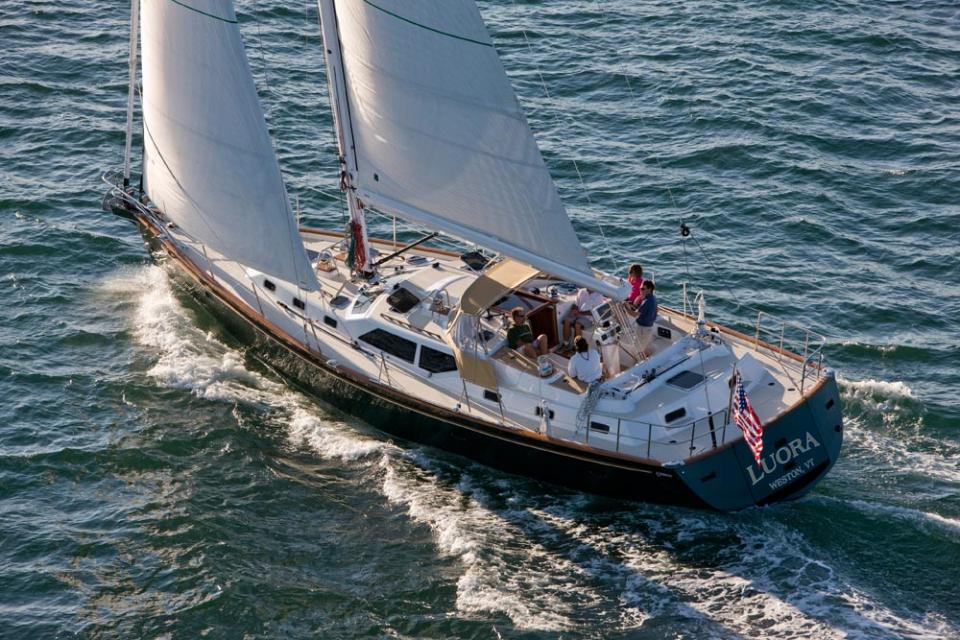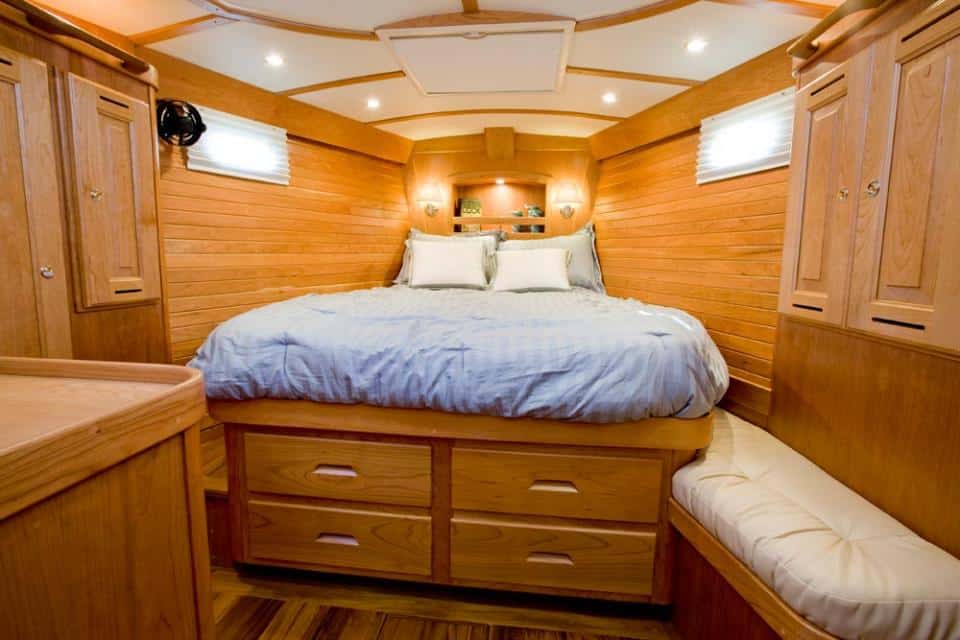
Let’s begin at the end-the aft end of the boat, that is. It makes sense, for soon after boarding the new Tartan 5300 last fall off Annapolis, Maryland, the very first feature we examined in depth was the drop-down transom door, a surprisingly uncomplicated arrangement lowered and raised, effortlessly, with a simple block and tackle. In its down position, kissing the wavelets, the stable gate serves as swim platform, sun deck, dinghy boarding step, and even garage door, for it opens upon a generous storage locker under the aft deck. As we got under way and the gate was raised to vanish seamlessly into the sweet reverse transom, my main thought was “Now that was cool.”
I’d return to that sentiment several times before the day was done.
Designed by Tim Jackett, the naval architect who’s become synonymous with the brand, and built to exacting standards-Tartan’s vacuum-infused epoxy-laminate construction is top shelf, yielding light yet bulletproof hull forms backed by the company’s 15-year no-blister guarantee-the 53-footer combines a raised saloon with a center cockpit and manages to marry those elements into a low, clean, well-proportioned profile that’s accentuated by a tall carbon-fiber spar and a Park Avenue-style carbon boom from Leisure Furl. In other words, it’s a strong, good-looking boat.
Thanks in large measure to what Tartan calls its Cruise Control Rig-known elsewhere as a Solent rig-the 5300 also sails very, very well. The versatile C.C.R. consists of dual headsails, a 108-percent working jib, and an off-wind reacher, both stationed well forward and controlled by a set of Harken hydraulic furling units. We tested the boat on a less-than-perfect day, with winds hovering in the 5- to 8-knot range. But the light air proved more than adequate to get the easily driven hull moving well. Upwind, once the boat had gathered way and began manufacturing its own apparent wind, the 5300 clocked along at a very respectable 5 to 6 knots. Cracked off, with the jib stashed and the big reacher unrolled, the boat still averaged an impressive 5 knots, basically sailing the same speed as the true wind.
Under power, the 5300’s 106-horsepower Volvo diesel, spinning a fixed, four-bladed propeller via a conventional shaft, was responsive and agile in forward and reverse. The boat was equipped with digital readouts, displayed on the Raymarine E80 chart plotter, for fuel consumption, rpm, tankage levels, and related outputs and functions. It was interesting to note that at 2,500 rpm, the boat made 7.7 knots while consuming 2.33 gallons per hour. But by easing back to 2,400 rpm, the boat still registered 7.4 knots while consuming only 1.96 gph. In terms of efficiency, it seemed like a worthwhile trade-off.
With the exception of the Spinlock clutches and the Lewmar Ocean Series chrome windlass, the Harken theme continues throughout the full winch package, the turning blocks, the mainsheet and traveler, the adjustable sheet leads, and in the company’s Battcar system for the fully battened mainsail. Other notable on-deck features include the custom stainless-steel chocks and cleats, the massive teak caprail, and the voluminous storage capacity in multiple deck lockers. Eight hatches and four dorade vents (with their handsome, matching stainless-steel guards) funnel plenty of fresh air below, and the dedicated chain locker and the adjacent storage locker forward are separated by a fully sealed collision bulkhead.
The sloped companionway ladder provides access to the accommodation plan; at the foot of the ladder lies the large opening floor hatch that gives access to the diesel engine and the optional generator. The 5300 is built on a semi-custom basis, providing owners with endless opportunities to personalize their boats. Large staterooms fore and aft balance most interior plans, including the one on the boat we tested, Luora, owned by Connecticut sailor Jeff Lennox.
It’s worth mentioning that the 5300 is an extended version of the company’s aft-cockpit 5100 but with a different transom extension. The extra 2 feet of length, in concert with the deck-saloon layout, provided Jackett with what seems like an exponential amount of interior volume with which to work, particularly in the owner’s spacious cabin aft and in the central living and entertaining areas at the core of the vessel.

The standard cherry interior is warm and inviting. Every interior plan to date features a sweeping settee to port in the main saloon with an accompanying dining table. On Luora, Lennox opted for a large desk and work area instead of the twin chairs and end table specified in most of the published accommodation layouts. Aft of the large forward double stateroom, Luora also has twin bunks in a separate compartment to port, with a head and shower to starboard. The straight-line gourmet galley is also to port, aft of the main cabin, while a large head occupies the same space on the starboard side.
The one and only criticism of the 5300, if that’s the proper word, is that the systems-rich vessel, with its vast, integrated array of hydraulics, electronics, machinery, a 110-volt AC system, and 12- and 24-volt DC systems, is certainly not a yacht for a novice boatkeeper. Tartan has done a remarkable job assembling detailed handbooks and schematics for virtually every aspect of the vessel, and Lennox had nothing but positive things to say about the builder’s service and support at every stage of Luora’s construction process and commissioning. But he also seemed to be an unusually technically savvy sailor, and the Tartan 5300 deserves, and requires, nothing less.
In the end, after all, it’s a boat with the capacity and potential to voyage to any corner of the watery world. Tartan clearly wanted to make a statement with the 5300, and in doing so, the company has delivered not only a flagship for the brand but also arguably one of the better American-built cruising boats that I’ve seen in the new millennium.
Herb McCormick is a CW editor at large.








